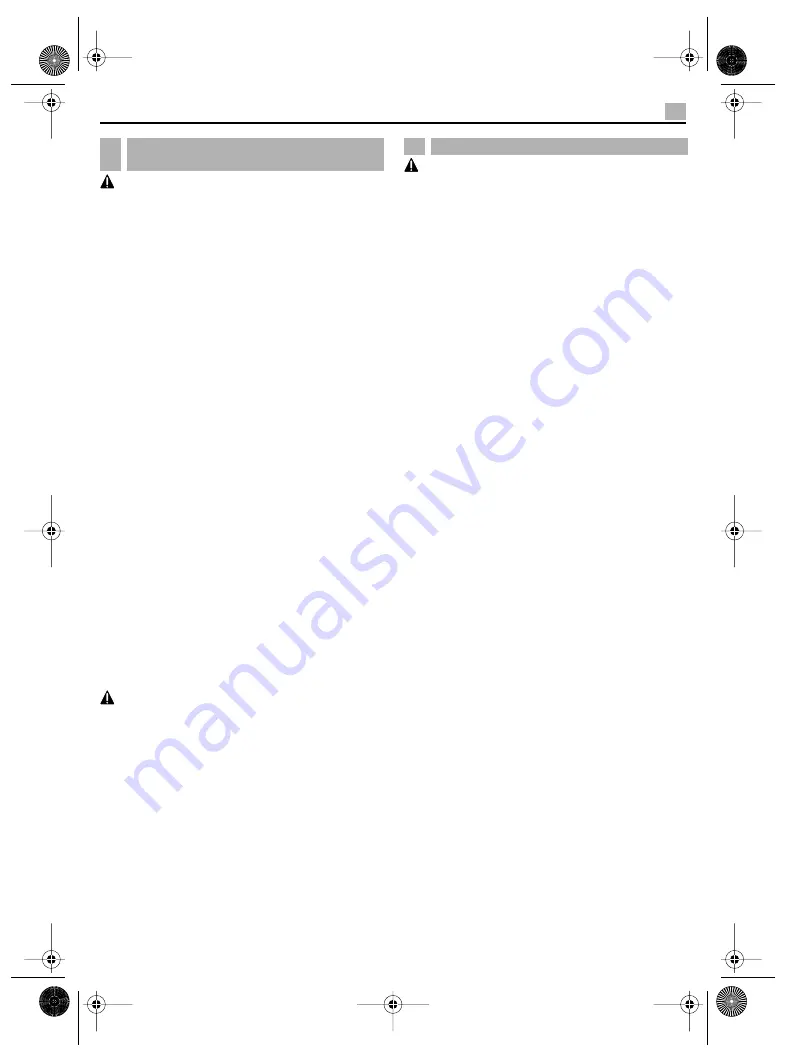
900 HEX/2
English
9
Before any work on the machine itself, pull the
mains plug!
Mounting the curved handle 5 (Fig. A)
The curved handle can be mounted in 3 positions
according to the application and preference of the
user. For mounting in the middle on the top of the
rubber head please proceed as follows:
Position the curved handle with spacer 2 onto the
machine such that the screw of the curved handle
comes lies over the screw opening on the rubber
head.
Turn the locking grip 3 clockwise until the curved
handle sits tightly.
To bring the locking grip back into position over
the curved grip again, it can be lifted, turned to the
required position and latched.
For mounting at the side on the right or left of the
curved handle, proceed in a similar manner but make
sure in doing so that the lugs 1 of the spacer notch in
the recesses 11 provided in the extension of the ven-
tilating slot on the rubber head.
Adjusting the curved handle
The angular position of the curved handle can easily
be adjusted in all 3 positions as the user wishes.
Continue to unscrew the locking grip anticlockwise
until the curved handle can be lifted out of the toothed
grid of the spacer.
Turn the curved handle to the desired position and
allow it to notch in the toothed grid of the spacer.
To tighten the curved handle proceed in the same way
again as for the assembly.
Connect the mains cable module to the handle. The
plug must latch.
Use the mains cable module provided only for
Kress Electro-Tools. Do not attempt to operate
other machines with the module.
Only use original Kress mains cable modules and
at least flexible rubber tube (code designation
H05 RR-F).
Check before putting into operation that the mains
voltage agrees with the voltage specified on the
nameplate of the machine.
Switching on and off
Turn the switching ring 6 in the direction of the arrow.
At the end of the turn the locking switch 7 automati-
cally engages.
By pressing the tilted-up front edge of the locking
switch 7, the switching ring 6 returns to its initial posi-
tion and the machine slowly comes to a standstill.
Full-pulse wave electronics with
tacho-signal recognition
The speed is kept constant due to the integrated full-
pulse wave electronics with tacho-signal recognition.
Gentle-start acceleration is also integrated in the
electronics.
The motor slowly accelerates until the pre-determined
speed is reached, thereby reducing the strain on both
the user and the transmission and prolonging the
service life of the machine.
The electronic overload protection limits the speed
if there is danger of the load causing damage to the
motor. The load on the machine must be reduced in
order for the full capacity to be made available again.
This is best done by briefly taking the machine away
from the work piece.
The thumbwheel 10 enables the optimum speed to be
pre-selected, also while running. The speed required
will depend on the working material and is determined
by trial and error (see application table).
The numbers on the thumbwheel 10 correspond
approximately with the following speeds:
Sanding Plate Brake
The integrated backing pad brake reduces the
number of vibrations at no-load, thus preventing
furrows occurring when positioning the machine on
the work piece.
A steadily increasing no-load speed indicates that
the brake ring is worn und must be replaced.
6
Curved handle and mains
cable module
7
Putting into Operation
1
4650 RPM
2
5800 RPM
3
7000 RPM
4
8300 RPM
5
9700 RPM
6
11000 RPM
900 HEX/2 - Buch Seite 9 Dienstag, 27. Juni 2000 8:06 08










































